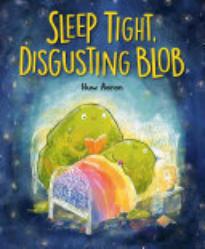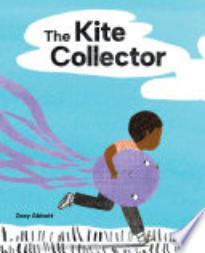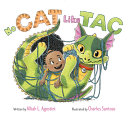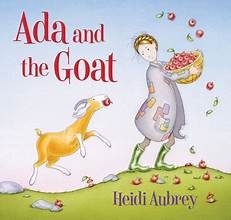Related
12,489 Reviews
(3)
K-3
A large green blob gently guides its young charge through recognizable bedtime rituals, encouraging their “horrible little one” to go to sleep. The lilting text and soothing rhymes are appropriate for the bedtime theme, even if the specifics aren’t: “Your duvet is soft and slimy. Your pillow is lovely and damp.” The warm muted-tone illustrations heighten the humor, showing Yeti settling down in her cave, Cyborg getting plugged in, Demon taking medicine, etc. (with some creatures more familiar than others: “Unspeakable Horror?” “Sentient Meteor?” The Spanish edition, Buenas noches, asquerosa cosa viscosa, will be published October 2025.
Reviewer: Kitty Flynn
(2)
K-3
"Everything was fine -- beautiful, tidy, safe, just right" with James’s pristine mounted kite collection before his little sister, GG, started walking. When she grabs his latest addition, he gets upset. “NO, GG! BAD, GG! NEVER, GG!” This makes GG sad, but James comforts her with a hug and then works odd jobs around the neighborhood to save up enough money to buy her a kite of her own. She takes it everywhere, and all is well until she wants to fly it. “No, GG! Flying kites is DANGEROUS! It could get TANGLED, TORN or fly away FOREVER!” A dream about a fluttering kite changes his mind. They have fun flying her kite together, but it takes a toll on the toy, and James goes back to work to earn money for supplies to repair it. The duo then works on the kite together. “Everything was fine -- pretty safe, a bit untidy and, somehow, just right.” Abbott’s use of repetition makes for a calming narrative that captures the common push-pull dynamic between siblings. Her lively illustrations, “made using multimedia materials and risograph printing” and primarily in shades of blue and green with yellow accents, capture the closeness between the two children and showcase James’s industriousness. His transformation may influence readers who are resistant to change to loosen up a bit, especially where younger siblings are concerned.
Reviewer: Marva Anne Hinton
| Horn Book Magazine Issue:
September, 2025
(2)
K-3
Illustrated by
Monica Arnaldo.
Cecilia, a Latine girl, juggles two jobs: kid and interpreter. Text bubbles in yellow for Spanish and blue for English differentiate the languages spoken by Cecilia's "clients" (i.e., her parents) and by those at "grown-up places," including the doctor's office and the DMV. As Cecilia dutifully translates questions, concerns, and instructions, Arnaldo's colorful watercolor and pencil-crayon illustrations elaborate on Abtahi's metaphor -- Cecilia appears to work in an office, wears an oversized suit and tie, and gulps down coffee -- while conveying, through her frizzing ponytail and rumpled jacket, the pressures of "working overtime." When Cecilia is asked about her feelings during a parent-teacher conference and admits the truth, her mother and father console her and promise to get more help. Abtahi, who took inspiration from her own multilingual childhood, strikes an important balance in her resolution: the necessity of interpreting for immigrant parents is not dismissed or shamed, while the pressure it can place on their children is addressed with empathy. After other family members step in to "pick up shifts" for Cecilia, she's able to continue helping her family while prioritizing her primary job: being a kid.
Reviewer: Ed Spicer
| Horn Book Magazine Issue:
March, 2025
(3)
K-3
Illustrated by
Avani Dwivedi.
In the mist-covered mountains of Meghalaya, India, a boy learns to build his community’s living root bridge under his uncle’s guidance, then works to repair damage caused by human-made hazards, rallying others to preserve it. Warm digital illustrations capture the lush setting. The evocative text invites reflection on the bridge’s importance, while the back matter -- an afterword, author’s note, glossary, and bibliography --provides further insight into the ecological and cultural significance of these unique, sustainable structures.
Reviewer: Summer Edward
(2)
K-3
Illustrated by
Lauren Tamaki.
This multilayered picture book offers a whimsical interpretation of the famous haiku “Old Pond” by the master poet Matsuo Basho (1644–1694) and celebrates nature and poetry with thoughtfulness and irony. After a walk, Basho stops beside a pond to rest and think. Knowing that he is “the most famous poet in the land,” three characters—a golden carp, a blooming lily, and a pesky mosquito—vie for his attention and poetic immortality. But none can disturb his reverie until a frog, ignoring them all, dives in for its carefree midnight swim. It is this act that startles and inspires the poet to compose his classic haiku: “Old pond— / Frog jumps in. / Splash!” Adderson’s spare telling offers layers of meaning and fun. The anthropo-morphic characters have lines of dialogue or thoughts well suited for reading aloud (“‘O, Basho,’ the carp called, ‘Look at me!’”), and each exemplifies a sensory mode: sight, smell, or sound, all helpful for modeling exploration of nature and writing poetry. Illustrations in acrylic ink recall the style of ancient Japanese ink painting, with each one awash in shades of green-to-yellow, or blue-to-purple, or both, and with perspectives from above, below, close up, and at a distance, providing movement and subtle humor. An endnote includes the poem in the original Japanese with a literal translation, as well as advice for writing nature poems.
(2)
K-3
Lenny, a small gray rabbit, and George, a large brown bear, are an inseparable duo, until Lenny begins to ponder the idea of spending time alone. George, less enthusiastic about the proposition, anticipates feeling lonely and believes "nothing could be as much fun as being together!" Confident about wanting to experience some independence, Lenny retreats to a cozy space large enough for only a tiny rabbit. "Here I am at last. In a quiet place. Alone." Lenny settles into an assortment of solitary activities, but eventually his thoughts return to George. And where is George, anyway? Agee's gouache illustrations, featuring black outlining and the use of solid colors against neutral-toned backgrounds, have a minimalistic composition with substantial negative space. His thoughtful exploration of negotiating togetherness in friendship is presented simply and is approachable for young readers, yet relatable for those of all ages.
(3)
K-3
Illustrated by
Charles Santoso.
A young Black girl brings home a rambunctious new “cat” named Tac -- actually a baby dragon -- who quickly becomes part of her blended family. When Dad’s frustration hurts Tac’s feelings, the girl must act fast to bring their runaway pet safely home. With playful repetition, heart, and humor, this whimsical picture book explores themes of family and belonging and celebrates how unexpected additions can make a home feel complete. Cartoony digital illustrations, enhanced with handmade textures, add warmth and charm.
Reviewer: Summer Edward
(1)
K-3
Translated by Michael Blaskowsky.
Is Sato a boy in a rabbit costume or a rabbit with a human face and bearing? Is he a kid or a grownup? What matters is that he's an alert, curious, questing creature who follows his imagination and his heart. In this pair of adventures, Sato plays with light. On one perfect day, a narrow band of sunlight between two curtains turns into a kind of benign lightsaber or magic wand that he wields to scoop up sparkles, gather sunshine, and stir his coffee. As dusk falls, he uses his captured beam of light for a comforting campfire and as one of the ingredients for a delicious sandwich. On another memorable day, Sato wakes up to discover that his bedroom has become a floating lighthouse. He tends the light, accepts gifts from birds and fish, and pays attention to an ever-changing world. A shell becomes a boat, clouds become a whale, a sliver of moon becomes candy, day becomes night. In simple declarative sentences and compositions made of ovals and blobs in warm pastel colors, Ainoya creates a world of kindness and abundance as the background to a story that needs no conflict to be fully realized, absorbing, and sweetly funny.
Reviewer: Sarah Ellis
| Horn Book Magazine Issue:
September, 2025
(2)
K-3
Illustrated by
Nancy Goulet.
In a rush of simple rhyming text, this fast-paced board book uses a racecar metaphor to take viewers through a day driven by a baby’s needs: “Baby Driver, rise and shine! Gear up at the starting line.” Like any racecar, Baby fuels up, does a few laps (in the living room in a toy car meant to support walking), and has a “blow-out” that requires a (diaper) change. Illustrations pop with bright primary colors, black-and-white check patterns, and thick black outlines to further evoke the racetrack. Baby’s footed pajamas, ruddy cheeks, and puppy sidekick keep the day feeling snuggly in spite of its whirlwind speed. In the end, Baby Driver gets a wash (as do some toy cars and the dog) before making it to the finish line with a final “beep!” The story provides plenty of rhythm and onomatopoeia for sharing and making noise with babies who are speeding through their own daily routines. (See also Floor It by Fine, in this issue.)
Reviewer: Julie Roach
| Horn Book Magazine Issue:
November, 2025
(2)
K-3
Illustrated by
Jerry Pinkney
&
Brian Pinkney.
When a brush fire begins raging, the animals flee to the river for safety—except for one determined hummingbird. The tiny bird carries drops of water in her beak, releasing them on the flames. The other animals view her efforts as futile until a wise elephant, moved by her persistence, asks why she bothers. “I am do-ing what I can,” the hummingbird says. The elephant responds, “Then I will do what I can.” One by one, the animals follow her example, coming together to fight the fire. Alper’s lyrical text, inspired by a parable shared by environmentalist Wangari Maathai, emphasizes the power of small actions leading to collective change. According to an illustrator’s note, Jerry Pinkney’s sketches for this, his final work, were lovingly completed by his son Brian Pinkney, whose painstaking “paint strokes and brush lines brought [his] father’s work to life.” The collaboration creates a visual experience that feels fresh. One aerial-view spread shows a host of animals—including giraffes, hippos, chimpanzees, elephants, and crocodiles—joining forces, offering a stirring depiction of resilience and teamwork. The contrast between the hot orange tones of the fire and the river’s cool blues heightens the book’s emotional impact. A stirring tale of courage, unity, and environmental stewardship
(3)
K-3
Illustrated by
Camilla Ru.
A young Black girl celebrates the beauty and versatility of her Afro-textured hair while exploring the deep connection she shares with her grandmother through their unique hairdos. Together, their hair tells stories of playful moments, memory, and Caribbean heritage. The lyrical text honors intergenerational love and pride in cultural identity. Big, bold, and colorful digital illustrations with vibrant patterns bring the story to life. A tender, joyful tribute to self-expression, ancestry, and the magic woven into every strand.
Reviewer: Summer Edward
(2)
K-3
Illustrated by
Lauren Hinds.
This enthusiastic story opens with Granny and a small goat looking lovingly at each other while laundry dries on the line. "Granny's got a goat!" This turns out to be an understatement: rhyming text ramps up the counting after the page-turn as more goats materialize in the background, climbing everywhere and nibbling the laundry. The colors and expressive shapes in the gouache, colored-pencil, and pen illustrations become more boisterous to match the story's escalating pace. Soon other people show up to help wrangle the goats, counting them in increments of ten until they confirm that one hundred are present (and wreaking havoc across the pages). The narrative expounds on how Granny gets through her day with all these goats and how occasionally one gets left behind (on the bus or at the hair salon, for example), while spot art provides visual comedy. Readers are encouraged to help perform a rambunctious recount, and indeed Granny is now one goat short. The whole town devolves into chaos knowing this troublemaker is at large, but venerable Granny ultimately gets everything under control...until the next count. The energy of the interactive text enables this story to work well as a group read-aloud, while the illustrations, full of funny details to note and one hundred mischievous goats to count and recount, make it equally effective for close looking and sharing.
Reviewer: Julie Roach
| Horn Book Magazine Issue:
July, 2025
(3)
K-3
Ada wants a life that is “quiet and ordered, simple and good.” Then she rescues a goat who is caught in a fence, and it follows her home. In short order, the goat destroys her nice coat, eats all her apples, and climbs up on her roof -- but Ada learns to appreciate the love and chaos the goat brings. The charming story is accompanied by graphite and watercolor illustrations with an old-fashioned feel.
Reviewer: Rachel L. Kerns
(1)
K-3
Illustrated by
K-Fai Steele.
Sure, Lena has buff feathers, a red comb and wattle, and the manic, beady eyes that Steele (illustrator of the Lone Wolf series, rev. 7/25, and others) is so good at drawing. But Lena knows she is a dinosaur. This sets her apart from the other chickens in the coop, in hilarious scenes that juxtapose her essential dinosaur-ness against her relations’ chicken-hearted natures. “Have some GUMPTION!” she clucks in disgust as the other hens cringe away from a tiny kitten; “Aim LOW and you’ll never be disappointed,” the other chickens advise her. Bailey’s (The Three Little Mittens, rev. 11/23) wry narration is paced so it practically reads itself aloud. It’s embellished by Steele’s energetic pencil and watercolor cartoons, which incorporate dialogue in speech bubbles and offer plenty of visual chuckles. When a weasel with a “magnificent set of whiskers” threatens the farm, he’s silhouetted against the sky like a B-movie villain. Of course it’s Lena, harnessing “something ancient, something primeval,” to the rescue in a comedic sequence that sends the now-whiskerless weasel running and that will have little listeners giggling. The story could end there, but it doesn’t. The young human child of the farm comes home with a book on evolution, and Lena is thoroughly vindicated. This makes for rather a long coda, but Steele’s light touch keeps the pages turning. A concluding note provides further scientific basis for Lena’s conviction and recommends two nonfiction books on the dino-bird connection.
Reviewer: Vicky Smith
| Horn Book Magazine Issue:
November, 2025
(3)
K-3
Illustrated by
Shamar Knight-Justice.
Rasheed, a young Black boy, grows up under the loving guidance of his big brother, Anthony, but when Anthony begins to seek independence, Rasheed must adjust -- until the day he becomes a big brother himself. Mixed-media illustrations full of layered textures and patterns invite readers to feel the closeness, joy, and emotional complexity of brotherhood and growing up. With an engaging first-person voice, this heartfelt picture book beautifully honors the beauty and strength of sibling relationships.
Reviewer: Summer Edward
(2)
K-3
A child spends the day with their grandmother fishing and then frying up their catch together in this tasty follow-up to Soul Food Sunday (rev. 11/21). The child narrates as the duo leaves before dawn, loading up their supplies into Granny's Jeep and heading for a pier on an Army base on the Chesapeake Bay. Once there, Granny, who is a disabled veteran, shows her badge to gain admittance. She prays "for a blessing" before making her way to the pier, where she's greeted warmly by the other anglers. Soon, Granny's line begins to "Bob-Bob-Bob!" and "Jerk-Jerk-Jerk!" as she reels in a big croaker. By sunrise, the pair have caught a bucketful of fish, and they head back to Granny's house, where they clean, batter, and fry them. The child is then inspired to make hand-rolled hushpuppies to accompany their meal. Finally, other family members arrive for the feast. Bingham captures the love that goes into preparing the food and the closeness between the child and Granny. Her use of onomatopoeia makes for a good read-aloud. Esperanza's oil paint and pencil illustrations feature bold colors, primarily in shades of blue, pink, and coral. The sankofa bird on Granny's T-shirt is a nice nod to the rich history of weekend fish fries in Black culture. An author's note and a cook's note are appended, along with a recipe for hushpuppies.
Reviewer: Marva Anne Hinton
| Horn Book Magazine Issue:
September, 2025
(1)
K-3
In Blackall’s earlier picture book If I Was a Horse (rev. 9/23), a child imagines life as a spirited steed; activities include giving little sister a ride to school. In this clever follow-up, a bossy kid (wearing the same blue party hat as that horse/child) confidently declares to a younger one, “If we were dogs, I’d be a big dog! And you’d be a little one!” A boisterous golden retriever then leads a small dog in a classic canine romp: tail wagging, water drinking, stick fetching, hole digging. The less-than-enthused pup reluctantly follows along as they venture out to a park to play with “millions of dogs”—but only the golden is having fun. After the little one confesses, “I don’t want to be a dog,” and shouts, “Sometimes I HAVE IDEAS TOO!” the game continues, but this time the golden is accompanied by a much happier-looking animal: “QUACK!” Audiences will enjoy going back to find sly hints in the art that a certain someone is quite fond of waterfowl. While the front endpapers contain silhouettes of many dog breeds, including the canine protagonists, the back endpapers fittingly present silhouettes of a whole variety of animals, including a golden retriever and a duck—and a horse! Blackall’s impeccably detailed, highly expressive illustrations add heart and humor to this tale about the endless paw-sibilities of pretend play—and the importance of speaking up for oneself.
Reviewer: Jennifer M. Brabander
| Horn Book Magazine Issue:
November, 2025
(2)
K-3
Illustrated by
Brizida Magro.
This tender, deeply empathetic story, narrated by a child grieving the loss of a sibling, offers a moving exploration of grief's many layers. "There's a hole in the bottom bunk where my brother, Matty, used to sleep," the narrator reflects on the first page. The illustrator visualizes this hole as a black scribble drifting throughout the house, a metaphor for grief that captures its persistent, all-encompassing nature. The hole appears beside Mom and Dad as they try to carry on and, affectingly, over their hearts as the family sits together at dinner. "I hate these holes," the narrator confesses, as classmates react in varying ways: some ignore them, some fail to notice. A friend, Nora, takes a different approach. Curious about the hole, she stays by the protagonist's side as her friend descends into it, spotlighted in the emotional illustrations by a warm yellow light. The story reaches a cathartic turning point when the child collapses in sorrow, shouting out, "I miss you, Matty." In the quiet that follows, Nora encourages her friend to share stories. These recollections bring them to vivid life, later brightening the mood at the family dinner table and offering a sense of connection and healing amidst their shared loss.
Reviewer: Julie Danielson
| Horn Book Magazine Issue:
March, 2025
(1)
K-3
The family from The Airport Book (rev. 5/16) and The Hospital Book (rev. 3/23) is back, here on the brink of moving—again. As always, there's plenty to take in, smile at, and relate to. Brother and younger sister, who is looking worried and apprehensive, sit on the front steps of their "sold" house while he reminisces about all the other places they've lived. From a tiny apartment she doesn't remember because she hadn't yet been born, to a "big apartment in [a] big building with three elevators" where they didn't even need to go outside to trick-or-treat, to their current house full of vivid memories, we are treated to an intimate portrait of a growing family and, in particular, these characters' childhoods. Lighthearted elements, especially regarding the unreliability of the brother's narration (he claims to be much more adventurous and uncomplaining than the art reveals), mix with more poignant ones (Grandpa, who will be living with them in the new house, now uses a walker). Brown's mixed-media illustrations feature their usual clear colors, clean lines, and wealth of detail. Sharp-eyed readers will note that this time the sister's beloved Monkey gets its own labeled box—no more getting lost!—and will be reassured to see that her smile has returned by book's end, as the family settles in happily to their new home.
Reviewer: Martha V. Parravano
| Horn Book Magazine Issue:
July, 2025
(2)
K-3
Translated by Laura Watkinson .
Things go awry at the Dinosaur Museum on a busy Thursday at closing time—with the coat check attendant’s parakeet making the rounds. A child named Yuri is balancing precariously on the guardrail near two large dinosaur skeletons when Yuri’s fear of birds leads to a “really big catastrophe!” While the child cowers at the sight of the immense pile of collapsed dinosaur bones, the second-person narration guides readers through a breathing exercise: “But then you calmly breathe in and out two hundred and eighty-three times. It takes a while, but it really does help to blow away the worst of your worries.” It also helps that all the visitors react with kindness. Soft illustrations with detailed line work capture the great scale of the museum and its dinosaur skeletons contrasted with the museum visitors and the tiny parakeet who flits from scene to scene. Smart page compositions rely partly on the museum architecture to visually tell the story, while the text helps mollify the general fear and embarrassment mis-takes can produce. It takes all night, but by morning the museum-goers have helped put those dinosaur bones back together again, though arranged in a different way that pays homage to the parakeet’s heritage in the dinosaur world. Full of details to observe, this Swiss import manages to combine dinosaur drama with practical emotional support for persevering through embarrassing moments.
Reviewer: Julie Roach
| Horn Book Magazine Issue:
November, 2025
12,489 reviews
We are currently offering this content for free. Sign up now to activate your personal profile, where you can save articles for future viewing.
























